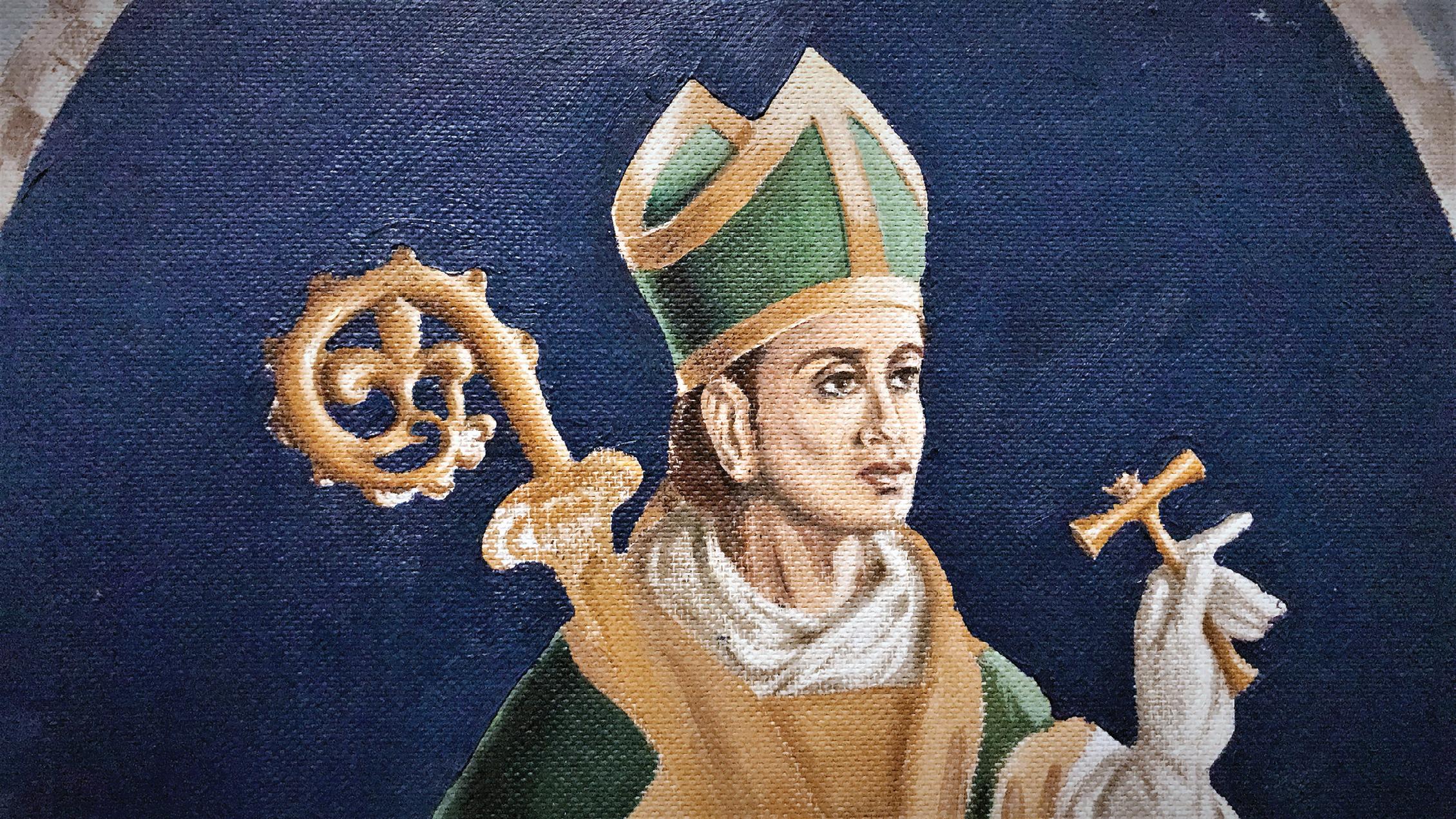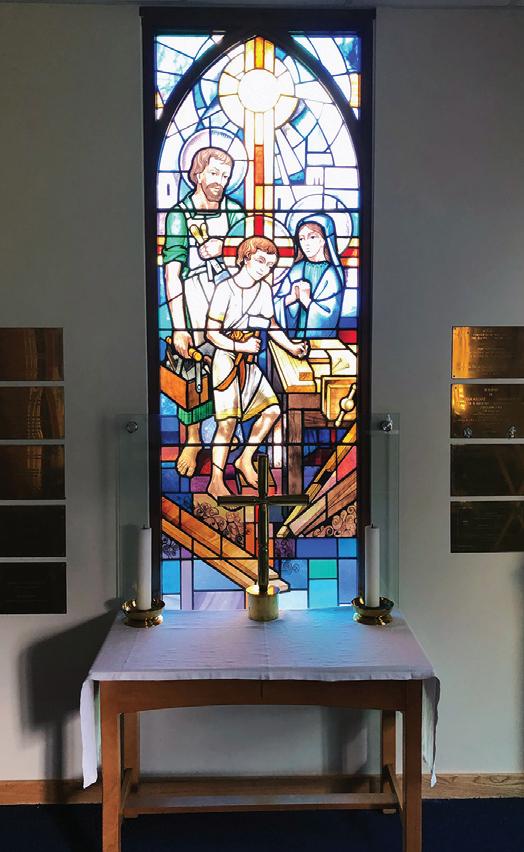
7 minute read
St Eligius, REME’s Patron Saint
REME History
St Eligius, REME’s Patron Saint
Advertisement

Painting of St Eligius from an altar piece displayed in several REME garrison churches, recently acquired by the REME Museum.
A key characteristic of the REME Soldier is that they are a Soldier first but a tradesman always. It only makes sense that our Corps patron saint would also have been a tradesman. Kimberley Day, Assistant Curator at the REME Museum, and Corps Welfare Warrant Officer WO2 Kelvin Redshaw share the story behind the artisan who became a bishop.
On 1 December the Corps marks St Eligius Day, a celebration of REME’s patron saint, St Eligius. But why does the Corps have a patron saint? And how was Eligius chosen? We’ll fill you in.
Warriors and Craftsmen
We might think of saints as serene and peaceable, but the connection between these holy figures and the military goes back millennia. Saints associated with the Armed Forces include St George, who is said to have been a Roman soldier; St Barbara, associated with risky jobs and explosions; and Joan of Arc who is known for her bravery and military victories.
Other saints are tied to professions, most notably to artisans and craftsmen. Medieval trade guilds had their own saints. St Ambrose, for instance, watches over beekeepers and candle makers. Patron saints have been popular in more recent history too. All kinds of organisations have chosen saints, including some – but not all –Corps and Regiments of the British Army.
A fifteenth-century engraving of St Eligius in his busy workshop. Public domain via Wikimedia Commons.
Who was St Eligius?
St Eligius, also called Eloi and Eloy, was a goldsmith before he was a saint. He was born around 588 in modern France, most likely in Chaptelat, near Limoges. While still an apprentice Eligius was commissioned to create a throne for the king of the Franks. By skill or by miracle he was able to make two golden chairs with the materials needed for one. Inspired by this story, his later venerators were metalworkers and other craftsmen.
Earning respect for his achievement, Eligius soon joined the royal court and became an influential advisor and later a bishop, known for his charity and the monasteries he founded. Another legend tells that Eligius exorcised a demon from a horse by chopping off its hoof, fitting a horseshoe and then reattaching the beast’s extremity. For this reason St Eligius is also the patron saint of horses, vets and blacksmiths. “In the life of St Eligius, we can pick out the values and standards we still
live by as Soldiers and Officers…”
Choosing a Patron Saint
The decision to adopt a patron saint for the Corps was not made until 1959. Two REME Officers were tasked with researching thousands of possible saints. They created a shortlist of likely candidates and presented it to the Chaplain General of the Forces. Once approved, the list was passed to the Corps Committee. Out of the numerous options the Committee choose St Eligius.
In an article for The Craftsman Magazine, printed in July 2009, Colonel (Retd) M E Sibbons, then Corps Archivist, summed up the reason why St Eligius was chosen. ‘There were many good reasons, therefore, for choosing St Eligius as our patron saint. During the first part of his life he was, in succession, an apprentice, a skilled craftsman, and manager of a workshop; he served his rulers at home and in foreign lands; he spent the evening of his days training others; in his early years,

St Eligius’s Thrones
St Eligius showed a natural artisan flair from an early age in the skills of engraving and smithing; from this he undertook an apprenticeship to become a goldsmith. His trade eventually took him to the palace of the Franks in Neustria. Here he became known to King Clotaire II, who commissioned him to make a throne. With the materials he was given he made not only one throne but two.
His friend, Dado, Bishop of Rouen, wrote of him:
“And from that which he had taken for a single piece of work, he was able to make two. Incredibly, he could do it all from the same weight for he had accomplished the work commissioned from him without any fraud. Not claiming fragments bitten off by the file or using the devouring flame of the furnace for an excuse, but filling all faithfully with gems, he happily earned his reward.”
Clotaire II was impressed that he had not fraudulently kept the remainder of the material and had instead put it to good use. With this, and St Eligius proving himself as an industrious artisan, he was awarded a generous bag of gold and appointed Master of the Mint. Coins are still to be found with his name upon them.
This painting in the Chaplaincy at MOD Lyneham shows St Eligius with one of the thrones he made
More solemn celebrations take place in Garrison churches. The multi-denominational Corps Church of St Eligius, close to the REME Garrisons at Bordon and Arborfield, was the site of many sermons on St Eligius. Dedicated to REME’s patron saint in December 1989, the site had, appropriately, been a stable. In 1992, beautiful new stained glass windows were installed, including one featuring St Eligius.


according to legend, he was brought to realize the danger of pride and the value of humility; and throughout his life he displayed the qualities of courage and service. It would be difficult to find a better inspiration for members of our Corps.’
In the life of St Eligius, we can pick out the values and standards we still live by as Soldiers and Officers of The Corps of Royal Electrical and Mechanical Engineers.
Celebrating St Eligius
Over the last sixty years, St Eligius has become part of Corps life. St Eligius Day services and events take place on 1 December every year or the closest weekend, marking the anniversary of his death in 660AD aged 72.
REME Battalions, Reserves and affiliated cadets often take part in engineering challenges, sporting events or team activities to honour the saint, along with a meal. Several sporting fixtures have also been named after Eligius.
Since the move to MOD Lyneham, the Chaplaincy has been home to the St Eligius Memorial Chapel of The Corps of Royal Electrical and Mechanical Engineers. St Eligius at the REME Museum
There are a number of artefacts in the Museum’s collections that feature the Corps’ patron saint. You can also find a display dedicated to Eligius in the Trades gallery. The Museum is closed right now because of the new lockdown but we hope to welcome you back soon.
Did you celebrate St Eligius Day this year? The Museum is interested in preserving how REME personnel adapted events in light of COVID-19. If you took photos of your 2020 St Eligius Day activities drop us a line on enquires@rememuseum.org.uk.

From Artisan to Artisan-Bishop


St. Eligius was chosen to be Bishop of Noyon and Tournal. He took a leading part in religious life but for the whole of his life also continued to practise and master his craft. He won the confidence of kings and queens, was acclaimed for his high ethical standards within his craft and community and was always keen to demonstrate and pass on his skills to others. He appears to have been a people person and remained loyal and untiring in his efforts for the less fortunate, a motivating force in the development of a strong community. St Eligius most certainly took on the artisan traits from his father: leading by example; a hands-on approach; and a willingness to pass on his practical Some of the stained glass windows can now be skills to all he met.
seen in the Chaplaincy at MOD Lyneham.
To find out more about St Eligius and other key figures from Corps history, check out the REME Museum’s blog http://www.rememuseum.org.uk/category/history/









